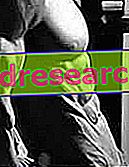A training aimed at the development of the definition has as main objectives the loss of body fat and the maintenance or increase of the muscular masses.

Training for muscle definition will therefore need to focus mainly on reducing body fat and to a lesser extent on maintaining / increasing muscle mass. Reconciling these two aspects is not at all easy since while muscle growth requires a substantial caloric surplus, on the other hand, to promote weight loss it is necessary to introduce fewer calories than you consume. This apparently banal reasoning can be questioned by analyzing the functions of certain hormones. Without going too far into specifics we can say that there are two very important hormones that favor the increase in muscle mass and the definition and two others that contrast it. These hormones are respectively testosterone GH (anabolic hormones) and cortisol, prolactin (catabolic hormones):
Lactic acid greatly increases the secretion of anabolic hormones. Anaerobic exercises stimulate GH and testosterone production more than resistance activities (running, cycling, cross-country skiing, etc.). The response of these hormones to exercise is greater the lower the degree of training of the subject.
The levels of cortisol, glucagon, ACTH and prolactin increase during long-term physical exercise and especially when the exercise is performed fasting or under conditions of psychophysical stress. If the aerobic activity lasts over 45-60 minutes there is a significant increase in the plasma levels of these hormones.
After analyzing the most important hormonal functions and their influence on muscle definition, we open a small parenthesis on body metabolism and the role of various sports activities.
For an active person, body metabolism (the rate at which the body burns calories to satisfy vital needs) depends above all on energy expenditure induced by physical activity and basal metabolism (minimum energy expenditure necessary to maintain vital functions and the state of wakefulness).
The basal metabolic rate is closely related to the lean mass of the subject: the more muscles you have and the more calories you consume during the day. Therefore weight training stimulates the increase of basal metabolism.
The energy expenditure caused by physical activity depends on the type of sport practiced and on the duration and intensity of the training sessions. During a weight training, few calories are consumed (normally no more than a hundred). On the contrary, during an aerobic job such as running, many calories are consumed (500-800 Kcal per hour) and the body's metabolism remains high even for several hours after the end of the training (up to 10-12 hours). This increase leads to a total burn of twice the energy spent directly during the year.
By putting together all the statements made so far you can get several useful tips to increase your muscle definition:
training should optimally integrate weight training and aerobic work. The possible strategies to adopt are, in order of preference:
aerobic training in the morning (30-40 '), with weights in the late afternoon or vice versa (30'); 4-5 sessions per week)
weight training and aerobic every other day (2 aerobic sessions (45 ') + 3 with weights (45') per week); in total 5 sessions per week
circuit training (alternating aerobic exercises with weight training) (60 'total x 2 times a week) + 2 weight training (40'); in total four weekly training sessions
weight training (35-40 ') followed by aerobic training for the definition (25-30'); four weekly training sessions
These indications are suitable for a mid-level person with a few years of weight training behind them. The advice given must therefore be adapted to the individual characteristics and needs.
The muscle strengthening sessions will be characterized by high intensity and recovery times between the series of no more than 2 minutes. High intensity is the key to achieving an optimal definition; it is therefore advisable to use important loads in multi-joint exercises (always with an eye to safety); for the same reason it is necessary to tighten the teeth during the isolation exercises trying to go beyond the muscular burning (do not rely too much on the number of repetitions reported on the card).
In a training program for the definition there is no need to miss specific leg-strengthening exercises; both for a speech related to the increased hormonal secretion, and for the increase in metabolism induced by the accumulation of muscle mass.
To improve the definition, it is advisable to change the training program frequently in order to "shock" the muscle fibers (the response of anabolic hormones to physical exercise is greater the lower the degree of training of the subject).
Avoid training on an empty stomach. During training keep yourself well hydrated by always carrying a bottle of water.
After training, replenish lost calories with a fruit and a rapid assimilation protein source (eg branched amino acids, whey proteins).
Do not neglect the importance of rest. If you have been engaged in the definition for several weeks now, you feel physically exhausted, tired, chronically exhausted and the aesthetic goal is still far away, take two weeks off.
If you pay attention to these simple tips in a short time your definition training will bear fruit.
To optimize the beneficial effects it is important to associate a rational diet that speeds up the body's metabolism with a targeted training program. See: Speed up metabolism



